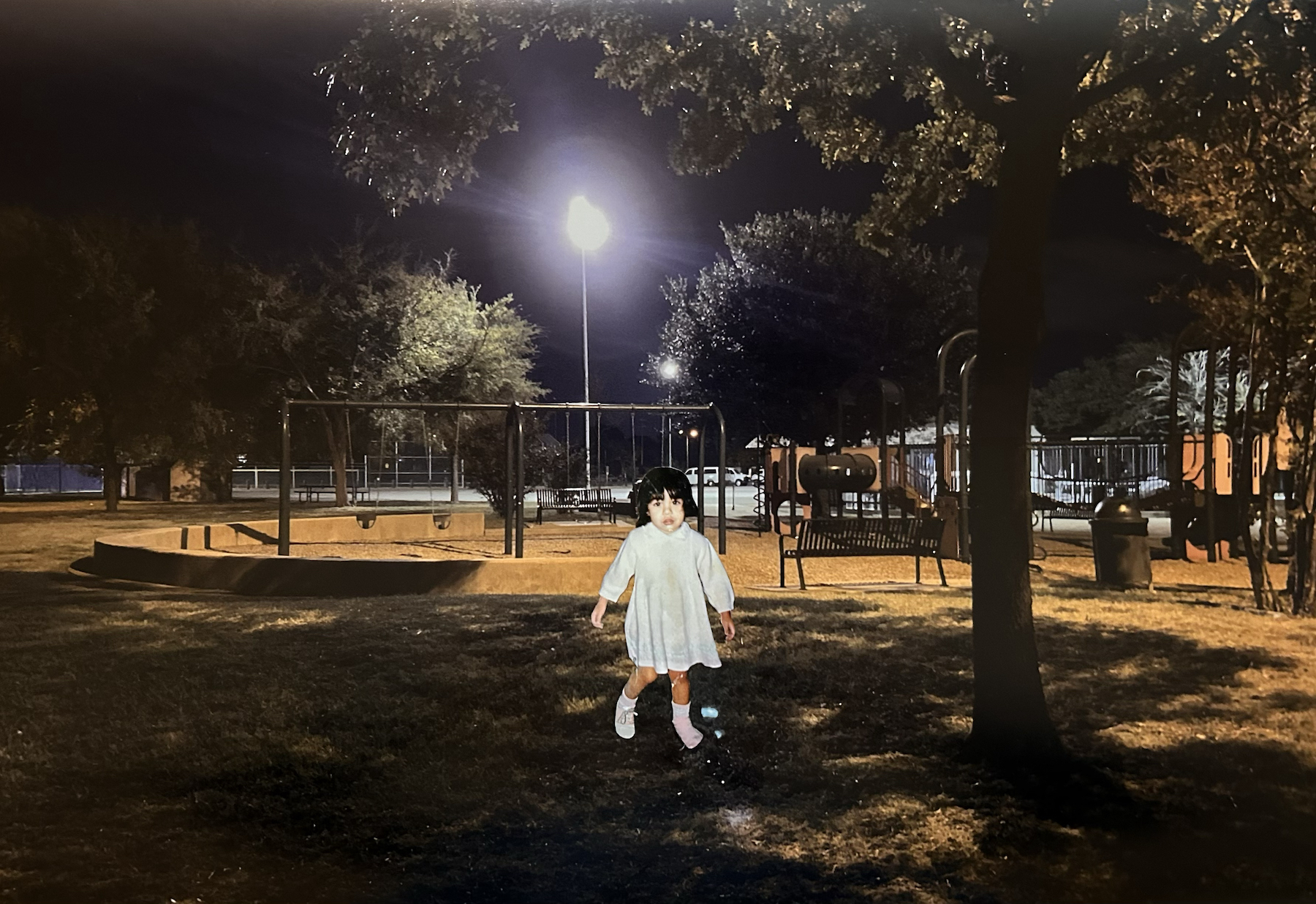It’s been 22 years since multi-disciplinary artist Nora Soto has called the Bachman Lake area home, but those experiences haven’t left her.
She wishes the first 16 years of her life near Webb Chapel were a time of nourishment, development, and introspection. But they were not. She grew a shield of armor in those formative years, a shield that she today describes as impenetrable. Years of trauma provoked by poverty, lack of advocacy, and violence hardened the surface. She polishes her armor with humor.
“I would tell stories of my childhood to friends and I would think they were so funny,” Soto says. “They’d be like, ‘What are you talking about Nora? That’s awful!’”
For her inaugural exhibition “I Want to be Soft” at the artist-run 500X gallery, Soto is turning these stories into art. She returned to Webb Chapel with her camera to revisit the landmarks of her childhood and recalls “memories she had decided were best forgotten.”
She explores her adolescence in the underserved neighborhood through photo and collage work. She layers photos of her childhood and drawings on top of current photos of the Webb Chapel area. The process was healing for her, she said.
“Art serves a purpose of being cathartic, being therapeutic, being a release,” says Steven Hector Gonzalez, Soto’s mentor and part of her 500X cohort. “Often for people, art is like a process to reevaluate who we’ve become and how we become that individual.”
In one piece, Soto recalls when she was 13 years old and ventured out with her 11-year-old brother. It was 1998. The duo trekked down Chapel Creek Circle, headed south on Webb Chapel Road, and walked to Fiesta Mart.
There, they slid pencils, erasers, pens, and colored pencils into their pockets, something they had done many times before. It was out of necessity; they needed school supplies. School was a daily reminder of what they did not have, but asking their mother wasn’t an option. She was a single mother of six who worked three jobs. A language barrier prevented her from accessing resources and welfare. Putting food on the table was a feat.
As they left the grocery store, security grabbed them and hauled them into the loss prevention office.When asked how many times they had done this, Soto answered “three.”
“Third time’s a charm,” Soto recalls security saying.
They received a lecture followed by a call to their mother. Soto sulked, angry and defiant. Her mother arrived, veiled with embarrassment, and gathered her children.
This experience forms the basis of what she titled “Third Time’s a Charm.” A black-and-white drawing of Soto and her younger sibling is adhered onto the left side of a present-day 18×24 photograph of Fiesta Mart’s school supply aisle. A full-color image of the backs of two White officers is adhered in the right. One officer bears a black swastika drawn on the backside of his head. The police officers and swastika symbolize institutionalized White supremacist ideology, Soto says.
“A survival tactic that I had was to wear things like a badge of honor,” Soto says. “I’d take anything that seems really crazy to some people, like getting jumped, and to survive the criticism or the judgment of people, I wore those things like a badge of honor.”
Six collages are woven on top of pieces of chain link fence with delicate, tan straw. Like “Third Time’s a Charm,” each carries a memory that is ingrained in Soto’s tough exterior. The seventh piece in the collection is a framed drawing of a girl laying her head on a pillow. A knife is under it.
In “Ricky,” a black-and-white drawing of a boy is pasted onto a photo of an apartment complex parking lot. The sky is vibrant and blue. A plane flies overhead. The boy is crouched on the floor, unconscious. An image of a scorpion sits behind him.
The piece conjures memories of a time when fighting was an instinctive response to confrontation and discomfort.
“This [fighting] was my way of doing something that I could control,” Soto said in an audio excerpt for Set Performance Journal.
Soto’s stomping grounds extended from the southern boundary of Harry Hines Boulevard to Northwest Highway. It was bounded on the east by Marsh Lane and Forest to the north. Her family moved often. They jumped from apartment to apartment to take advantage of new renter specials throughout the area.
“Those people that own those buildings are completely slumlords,” Soto says. “They take advantage of the fact that these people are undocumented and do the bare minimum to have the apartments operational.”
Some apartments Soto lived in didn’t have central air conditioning, she said. Security gates rarely worked.
The area is predominantly Latino and impoverished. Many families are first- and second-generation whose heads of households only spoke Spanish.
Soto’s childhood friend Erica Franco says most of their peers came from single women-led homes. Franco’s home life was different. Her family was nuclear. They had hardships, but her parents were present. The family reached a pinnacle many others didn’t: homeownership.
When Franco was 7, her father moved them out of their trailer park home and bought a house on Storey Lane in northwest Dallas.
Her mother, a stay-at-home mom, was an active volunteer at school.
Her home became a refuge for her friends. Franco had her own room. Her friends routinely spent the night. They ate a warm meal and found comfort in the Franco home.
When she entered the workforce, she struggled with professionalism and presentation. The scrutiny of management showcased the division of classes.
“You realize a lot of people don’t grow up the way you grow up,” Franco says. “Your parents do certain things to survive and you do certain things to survive. It’s a hardening that you have to do to grow up and keep going.”
Children often bear their family’s struggles. They become their younger siblings’ caregivers. Their parents are forced to be absent; they had to work two or more jobs to survive.
Other children work to provide an income for their family’s needs. They are no longer children. They are a means to an end. Their youth is stolen by the need for survival.
Many seek belonging outside their homes. Some lean on fairy tales. Many find themselves pregnant as they seek happily ever after.
Since 2007, teen birth rates have declined in Dallas County. Yet, the birth rate for Hispanic teens was 3.5 times higher than the rate for White teens in 2020, according to The Texas Campaign to Prevent Teen Pregnancy.
Others, like Soto’s cousins, turned to gangs for belonging. Those gangs provided a present family with protection and unity, but their presence also led to over-policing of the area.
Joes Creek, a tributary of the Elm Fork of the Trinity River, kept her safe from the police harassment. She walked along the creek to navigate the neighborhood.
The creek came with its own danger. Her body carries the reminder of the time she escaped a man chasing her in the creek. A swift jump over a fence resulted in a finger cut so deep it left a scar. The cut required stitches, but medical care was inaccessible. Instead, she saved her mom the worry and doctored it herself.
“Nora’s lived quite a lot,” Hernandez says. “She’s been through a lot of things. This work came very naturally.”
Before she is an artist, Soto is an social justice activist. She is the co-founder of Our City, Our Future, “an organizing collective dedicated to cities divesting in policing and investing in communities.” She is also a frequent collaborator with Cara Mía Theatre, whose outreach includes the Bachman Lake area.
The 500X exhibition is her call for advocacy and resources to pour into the families and children of Webb Chapel.
Soto no longer visits Brownwood Park, where she spent many childhood nights crying. 500X Gallery and her peers now provide a sacred space. It’s a space where she can shed her hardened exterior. It’s a space of encouragement, belonging, and softness.
Soto welcomes Dallasites to open their eyes to the reality of growing up in Webb Chapel. The exhibition opened on Feb. 4 at 500X Gallery and will run until Feb. 19. The gallery is hosting an artist talk on Feb. 18 at 3 p.m.
“I don’t think anyone can truly understand my childhood,” Soto says. “My work is going to speak for itself.”
Get the FrontRow Newsletter
Author







